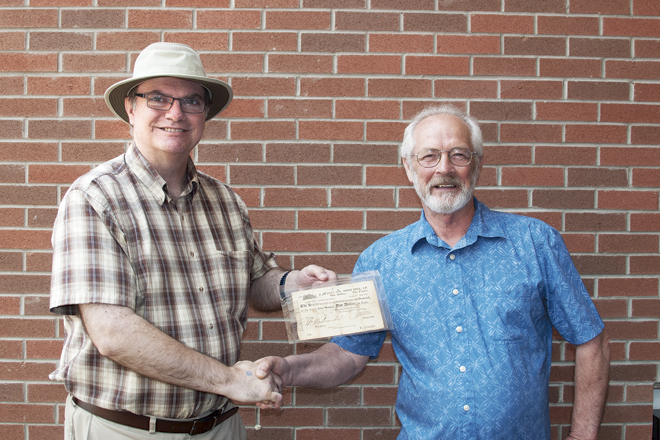By Jesse Robitaille
The Bank of Canada has bolstered its collection once again with the addition of an ultra-rare military banknote – the only of its kind known to exist – that tells the history of paper money and banking in Canada.
Sold by Georgetown, Ont. numismatic dealer Gary Fedora, the $1 banknote was originally issued in 1813 by the Army Bill Office in Quebec City. Now, it sits with hundreds of thousands of other currency-related artifacts from around the world at the Bank of Canada’s Currency Museum. The museum serves as the public face of its National Currency Collection, which is curated by Paul Berry.
“It’s the only one,” said Fedora, who added the bill was “well used” with fold marks showing how it was once held in a pocket or a purse.
“What we have here is a significant piece of numismatic history,” said Berry, chief curator, about the museum’s newly acquired army bill. “I’m just amazed.”
Fedora said he acquired the army bill from an Oakville man who called suggesting he had found something significant.
“We met locally one day, mid-afternoon, and I determined the note was real at that time,” said Fedora. “One of the major factors was the denomination letter, which was correct, and the note was definitely old, and the original embossing from the printing process was still on the note. It’s significant because if it was a copy, I doubt the compression would have been there, so it was printed by press rather than photocopy or something like that.”
From the outset of the War of 1812, there were concerns about how Canada’s colonial governments would finance its military expenditures. Previously, bills of credit were drawn by the British Treasury; however, a lack of specie led to the bills being over-issued, causing inflation and distrust towards paper money, which couldn’t, at the time, be exchanged.
“They could only redeem a very limited quantity of those notes, so that set a current of distrust, which didn’t change until the issuance of the army bills, which could be exchanged for hard cash like silver,” explained Berry.
On July 16, 1812 – a day before the Siege of Fort Mackinac, a British victory and one of the first engagements of the War of 1812 – the Governor of Lower Canada, Sir George Prevost, requested help from the House of Assembly in circulating army bills across Lower Canada.
“The bill was produced by the authorities for both pay and provisions of the troops in 1812,” said Berry. “Of all the notes in that period, this one represents the first instance of a paper currency in which the people had confidence.”
Later that year, the Army Bill Office opened in Quebec City, issuing $1 million-worth of bills in denominations of $4, $25, $50, $100 and $400.
In 1813, following amendments to the Army Bill Act, new notes were printed in smaller denominations of $1, $2, $8, $10, $12, $16 and $20.
By 1814, only two years after it was first enacted, the Army Bill Act had increased the maximum amount of army bills authorized for circulation to £1.5 million. The bills circulated in large numbers until the end of the war in 1815, when the British government redeemed them at full value, helping to restore trust in paper money and paving the way for the modern banking system.
Berry, who has worked with the Currency Museum for nearly three decades and as its chief curator since 2001, said the bill’s historical significance is what attracted the attention of the museum.
“As far as we know, this is a unique issue of the second series of army bills, and it’s something that’s unrepresented in the collection,” he said, adding there are other army bills in the collection but none quite like this. “We were very pleased to acquire it since it’s so closely tied to our history.”
Berry said he’s amazed by the bill’s mere existence.
“Despite the fact that almost 200 years have passed since the note was issued and the Army Bill Office in Quebec City was closed, another army bill has turned up,” he said. “It amazes me that something so fragile – because this note is very delicate and fragile – has survived 200 years of flood, fire and the all-around destructive influence of people in general.”
Fedora said the Bank of Canada is the “proper home” for the more than 200-year-old army bill, for which negotiations took about a year before the deal could be finalized.
“The proper place for it is the Bank of Canada. From the time I saw it, I knew in the back of my mind it would probably go there,” he said.
Despite the bill’s long journey, it’ll still be a couple more years before the public is able to see it again.
“It won’t be displayed until our renovations are complete,” said Berry. “We are not scheduled to reopen until July 1, 2017, at which point there will be a number of static and interactive exhibits, in which this note will be featured as a component.”

